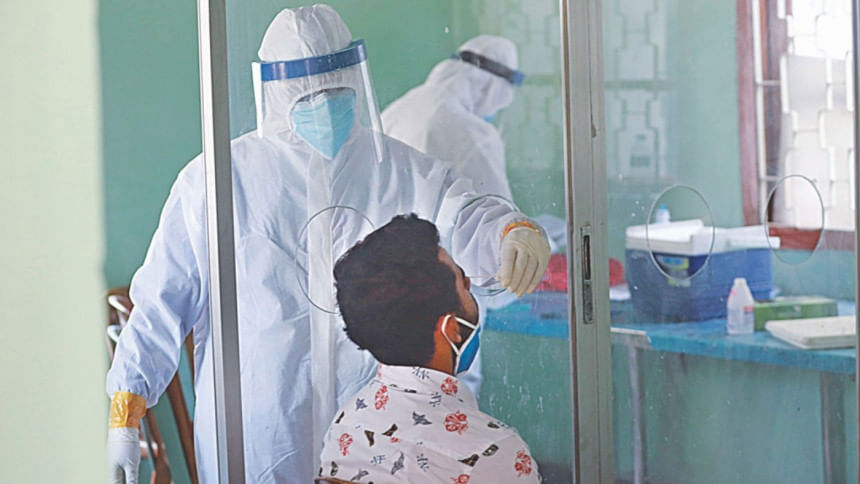Shielding frontline healthcare workers should be the priority

The coronavirus crisis continues to engulf the country as well as the rest of the world. A large number of doctors in Bangladesh (62 as of July 5)—mostly senior clinicians working on the front line—have died due to Covid-19. Many more frontline healthcare workers (over 5,000) have become infected. This is unusual compared to the situation in the western world. The entire healthcare sector was rightly shocked by this development and wants to know how the situation has deteriorated to this point.
I have spoken to a few of my professional friends in Bangladesh over the last few days. I have no doubt in my mind that this was mostly due to the Personal Protective Equipment (PPEs) currently in use by the frontline healthcare workers. In this connection, I would like to highlight the following issues.
Inadequate PPEs: In the beginning of the coronavirus crisis in Bangladesh, the government health services and the private healthcare authorities were unprepared. Healthcare workers were not provided with sufficient PPEs to protect them from coronavirus infections. Some clinicians even attended patients without using PPEs. Many of them made their own PPEs while awaiting delivery from their authorities. Supply of PPEs was delayed in many cases. Even we could hear the urgent call for help and requests for PPEs from a thousand miles away. I am aware that a few Bangladeshi volunteers from the UK and the USA have sent PPEs to help their fellow frontline fighters in Bangladesh.
Poor quality of PPEs: Many of the PPEs produced locally were not up to the World Health Organization (WHO) standards. There was hardly any quality control by the appropriate authorities in the beginning. This has meant a serious breach of the health and safety standards of healthcare and put the lives of frontline healthcare workers at risk.
Training on PPEs: Training on how to put on the PPEs (donning) and how to dispose of them (doffing) is limited in Bangladesh. Safe disposal of used PPEs is very important because these are most likely to be infected. There is a high risk of contracting the disease during doffing. Every healthcare facility in the country where Covid-19 patients are looked after needs to train their healthcare workers how to do donning and doffing safely. I have seen an excellent video on this issue posted by One Health Bangladesh in the social media. I would recommend every healthcare worker to watch this video carefully.
Mask fit test: An important element of the PPEs is face mask. The coronavirus spreads from the infected person to the healthcare workers via nose and mouth. We need to wear WHO-recommended face masks. We in the UK use mostly FFP3 masks and, in Bangladesh, N95 masks are being currently used. Every single healthcare worker in the UK, the USA, Australia and New Zealand had to go through the mask fit test. If you fail to pass a test for a particular type of mask, you are not allowed to use that mask during patient care. The risk of using a poor-quality, faulty or unfitted mask is contamination with the virus by breathing infected air around the edges of the mask and into the lungs. Mask fitting is usually difficult for a person with beard who may fail the standard mask fit test. However, beard-friendly respirators or masks are also available.
Unfortunately, as far as I know, the mask fit test is not available in Bangladesh. There are a variety of both manual and electronic quantitative mask fit testing machines available in the market. The manual (Medical Respirator N95 Fit Test) is simple but needs a protocol, testing methods and training. The electronic machine is expensive and needs software, a protocol, testing methods, accessories and training. One of the electronic machines is PortaCount Respirator Fit Tester 8048.
Shielding high-risk healthcare workers: In the UK, the NHS England has taken the policy of risk assessment of all high-risk frontline healthcare workers based on ethnicity, age, sex (male) and comorbidities. The high-risk vulnerable group of workers were either shielded at home or moved to a safer non-Covid-19 area of work. In New Zealand, high-risk healthcare workers (10 percent of the workforce) were sent home in the beginning of the Covid-19 infection. Now those workers are coming back to work.
We need to support and protect our vulnerable healthcare workers from the dangers of Covid-19. First we need to identify the high-risk group of health professionals based on age (50+plus years) and associated comorbidities, e.g. serious heart condition, chronic obstructive pulmonary disease (COPD), diabetes, chronic kidney disease, obesity and immunocompromised state. Then we urgently need to shield the vulnerable healthcare workers at home.
Covid-19 is a serious threat to our nation including the lives of the frontline workers, especially the experienced doctors. We need to save them from getting infected or worse. Otherwise, we may end up with a seriously damaged and broken healthcare system in Bangladesh in the future.
Md Salimuzzaman Bhuiyan is a consultant anaesthetist and intensivist, Furness General Hospital, and general secretary, Bangladesh Medical Society in the UK.

 For all latest news, follow The Daily Star's Google News channel.
For all latest news, follow The Daily Star's Google News channel. 



Comments